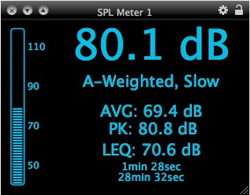The topic for this post comes from a reader who wants to know what he should do when faced with the requirement to mix no louder than 85 dB SPL peaks. That’s right, 85 dB peaks.
Why I Hate Volume Limits
I used to own a video production company. We were often hired to do video based on length. I always tried to talk the client out of imposing a length limit on a project saying, “The video needs to be as long as it needs to be, then it’s done.” I feel the same way about volume.
Ideally, the worship leader, front of house engineer and church leadership are all on the same page when it comes to volume. In that ideal world, the music will be mixed as loud as it needs to be to convey the power and energy (or lack thereof) required. The band, the song and the crowd will tell you how loud it needs to be. Go over that and it’s too loud; go under and it’s too soft.
Imposing a arbitrary limit on volume to me seems a bit like telling the pastor his sermon needs to be 3,000 words, no more, no less. But we live in a less than ideal world, and we have to live within arbitrarily defined volume limits. So what’s a sound guy to do?
Investigate
The first thing I would do when faced with a limit like that is find out where the number is coming from. Is it based in an inaccurate reading of OSHA hearing protection guidelines? If so, educate yourself and have a rational conversation with your pastor. Help him to understand that 8 hours of exposure to 85 dBA SPL in a machine shop 5 days a week is a whole different animal than 85 dBA SPL peaks for 15 minutes of worship music.
If that’s not the case, dig a little deeper and see where the number came from. Did someone wander by the booth one day and see 85 on the meter and think, “That sounds about right?” Are people complaining that it’s “too loud?” Is it really too loud or are there spectral balance issues? Or perhaps the setter of the number doesn’t like electric guitar. Or drums.
Acoustic drums will generate 85 dB peaks with the PA turned off, so you need to figure out where this is coming from.
System tuning and spectral balance are huge issues that can be addressed and give you a to more leeway in mixing at an appropriate level. 85 dBA mixes can still be excruciating, while 100 dBA can be enjoyable if done well.





















